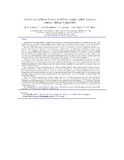| dc.description.abstract | The Neoproterozoic central African Copperbelt is one of the greatest sediment-hosted stratiform Cu–Co provinces in the world, totalling
140 Mt copper and 6 Mt cobalt and including several world-class deposits (P10 Mt copper). The origin of Cu–Co mineralisation in
this province remains speculative, with the debate centred around syngenetic–diagenetic and hydrothermal-diagenetic hypotheses.
The regional distribution of metals indicates that most of the cobalt-rich copper deposits are hosted in dolomites and dolomitic shales
forming allochthonous units exposed in Congo and known as Congolese facies of the Katangan sedimentary succession (average
Co:Cu = 1:13). The highest Co:Cu ratio (up to 3:1) occurs in ore deposits located along the southern structural block of the Lufilian
Arc. The predominantly siliciclastic Zambian facies, exposed in Zambia and in SE Congo, forms para-autochthonous sedimentary units
hosting ore deposits characterized by lower a Co:Cu ratio (average 1:57). Transitional lithofacies in Zambia (e.g. Baluba, Mindola) and
in Congo (e.g. Lubembe) indicate a gradual transition in the Katangan basin during the deposition of laterally correlative clastic and
carbonate sedimentary rocks exposed in Zambia and in Congo, and are marked by Co:Cu ratios in the range 1:15.
The main Cu–Co orebodies occur at the base of the Mines/Musoshi Subgroup, which is characterized by evaporitic intertidal–supratidal
sedimentary rocks. All additional lenticular orebodies known in the upper part of the Mines/Musoshi Subgroup are hosted in
similar sedimentary rocks, suggesting highly favourable conditions for the ore genesis in particular sedimentary environments. Prelithification
sedimentary structures affecting disseminated sulphides indicate that metals were deposited before compaction and consolidation
of the host sediment.
The ore parageneses indicate several generations of sulphides marking syngenetic, early diagenetic and late diagenetic processes.
Sulphur isotopic data on sulphides suggest the derivation of sulphur essentially from the bacterial reduction of seawater sulphates.
The mineralizing brines were generated from sea water in sabkhas or hypersaline lagoons during the deposition of the host rocks.
Changes of Eh–pH and salinity probably were critical for concentrating copper–cobalt and nickel mineralisation. Compressional tectonic
and related metamorphic processes and supergene enrichment have played variable roles in the remobilisation and upgrading of the
primary mineralisation.
There is no evidence to support models assuming that metals originated from: (1) Katangan igneous rocks and related hydrothermal
processes or; (2) leaching of red beds underlying the orebodies. The metal sources are pre-Katangan continental rocks, especially the
Palaeoproterozoic low-grade porphyry copper deposits known in the Bangweulu block and subsidiary Cu–Co–Ni deposits/occurrences
in the Archaean rocks of the Zimbabwe craton. These two sources contain low grade ore deposits portraying the peculiar metal association
(Cu, Co, Ni, U, Cr, Au, Ag, PGE) recorded in the Katangan sediment-hosted ore deposits. Metals were transported into the
basin dissolved in water.
The stratiform deposits of Congo and Zambia display features indicating that syngenetic and early diagenetic processes controlled the
formation of the Neoproterozoic Copperbelt of central Africa. | en_US |

